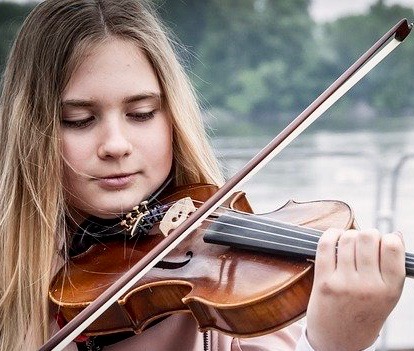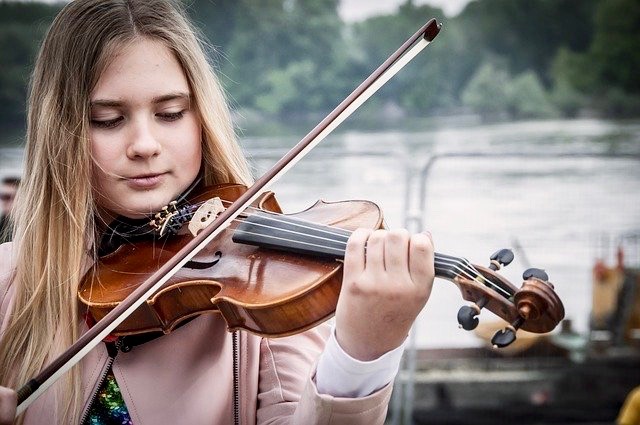How to Choose a Violin

What to Look for When Buying a Violin
If you have a question for our luthiers about instrument care, repairs, restoration, feel free to send an email to: luthier@fiddlershop.com.
How to Choose a Violin: 10 Factors to Consider According to Science
 Choosing the right violin can seem like a daunting journey, but there are many factors that can be taken into account to help you decide which is the best choice for you. The violin is an exciting and beautiful instrument that is comprised of many parts that all play specific roles in creating the sound it makes.
Choosing the right violin can seem like a daunting journey, but there are many factors that can be taken into account to help you decide which is the best choice for you. The violin is an exciting and beautiful instrument that is comprised of many parts that all play specific roles in creating the sound it makes.
Ranging broadly in price and quality, it can be hard to know where to begin when searching for an instrument. As the violin itself is only part of the puzzle of figuring out what you need to find in order to make the sound you want, this article will also include the accessories you will need for everything to come together.
Buying a violin is not like buying a car – You are not promised performance based on price. Although it is an investment, and you can certainly consider a very rare, high-quality violin an asset of sorts, you will need to try a lot of different types to find the violin you enjoy playing the most. Having said this, it is important to note that while you may consider your instrument an asset, it may not appreciate a particularly large amount of money with age if it is below a certain quality.
It is more common to find violins through dealers rather than auctions, but for buying your own violin to play at home, the most common route is a luthier or a music shop. Violins will vary in price greatly, depending on what you are looking for. Some violins may be extremely expensive, but as a player, you may find a cheaper option that you prefer the sound of.
The other things to consider are your bow, the way the instrument is set up, the strings – If you are comparing two intermediate violins at a luthiers’, and let’s suppose that they are on the higher end of the price scale, perhaps [15,000$ and 16,000$] apiece, the difference between them may not be colossal; however, if you decided on the cheaper option and invested the extra [1,000$] into your bow, it may make a huge difference to the sound quality. The choice of bow will make a very noticeable difference in one’s tone.
Does this sound like a lot to keep in mind? Never fear – This process should be an opportunity for you to try out instruments in order to find one you really like. Luckily, although there are many factors to consider, this process can be very enjoyable and rewarding if some key points are taken into consideration.
One of the first things to note before venturing into the quest for the ideal violin is that you will most likely be paying for more than the violin itself. Before considering the different factors that contribute to the violin, its tone and its playability, it is important to note that you will be buying the entire outfit, unless you are already a player, or buying a set with everything included. A case, bow, shoulder rest, and rosin are just some of the essentials that may not necessarily be included in the initial purchase, so bear this in mind when budgeting for your new (or old!) violin.
The violin will usually come with the bare bones of what is required, if you are seeking your beginners’ violin. Most will have the essential parts attached, such as the bridge, tailpiece, and, especially if you are purchasing a cheaper, beginner violin, a chinrest. It is common for a beginner violin purchased from a standard music shop to come equipped with strings (more on that later), and more often than not, a bow and a case. When looking at intermediate to higher-end violins, things change a little. A luthier will most likely be selling the violin separately from the bow, so if you are looking for something more advanced, be prepared to pay more and pay for the parts separately.
The Basics
Knowledge is power! A basic knowledge of the anatomy of the violin is a good thing to have when going into a music shop in search of a beginner violin. Although most staff in music shops will be able to explain this to you, some staff may only specialize in a certain type of instrument, so it is something to consider brushing up on.When buying a violin for a young person, the music shop staff or the luthier will usually be able to assist you, but a child or young person should be able to comfortably put their hand around the scroll of the violin without stretching their arm out straight. The sizes range from 1/16th up to full size. There are a number of helpful guidelines available online that show the different measurements, but going to test it out in person is the safest option. Nothing is quite as good as testing out an instrument in person, and having someone else accompany you to listen (more on that later on).
When purchasing a violin, you need to know how it sounds. If you are a beginner, you can ask someone else to play it for you. If the staff member you are dealing with in a music shop isn’t a violinist themselves, you can ask your violin teacher to test it out for you. Many people would be happy to do this. If you are already a player, you are probably already well informed about these tips, and are able to play the violin yourself.
Even an advanced player would usually consider asking another person to play the violin to hear how it sounds objectively. Remember to plan where you are going to play it. Are you borrowing it for a week from the luthier/music shop? Where are you going to try it out, a hall or a church? Perhaps you want to play it in a group setting, if you are part of a folk music group, or an orchestra? Hearing the instrument played, and playing it in different settings, will help you establish how much the instruments projects. These are all important things to think about when making sure you are choosing the best instrument for your needs. Remember, there are other factors to take into account – The strings and the positioning of the bridge, for example, will have a great amount of influence on the sound. We will discuss these factors later on. To read more go to the link below:

